Francesca and Henk-Jan's Backpacking Trip!
Sunday, April 25, 2010
DMZ
The day after the Golden Day before was a quiet day. On the 24th I went out to arrange a tour for the following day and I managed to get Francesca out of bed to eat a delicious meal at the Indian restaurant I'd found for her birthday. The rest of the day was rather uneventful, so here's a recount of the following day!
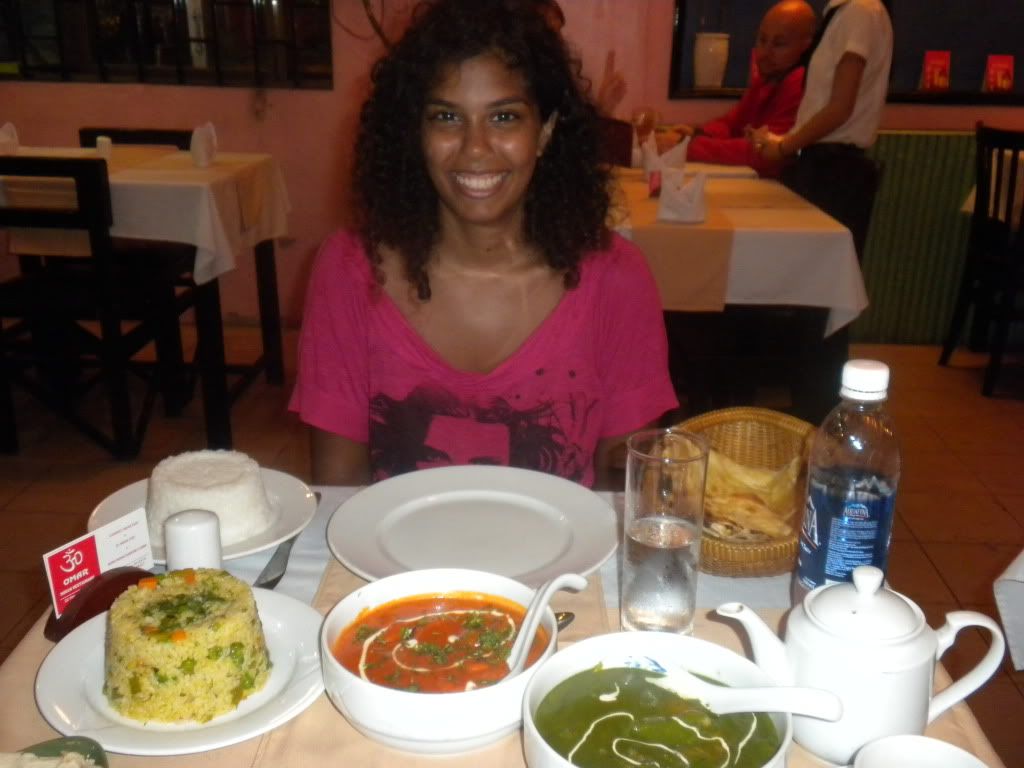
Francesca and I woke up at 7:00 AM to get ready for an early start to the 25th of April. Since I had booked the DMZ tour for us the day before, we were to be picked up at 7:30 AM. At 7:05 AM I was outside already, ordering us some take-away breakfast in the form of a fruit salad, a tuna baguette and a jelly baguette. A little before 7:30 AM Mr. Trung stood outside our hotel, ready to take us on a journey to the past.
As soon as we entered the car Mr. Trung told us the truth about today’s tour. The sites we were going to visit weren’t very special in themselves – in fact, most of them had already been destroyed by Uncle Sam or Mother Nature. It wasn’t the reason we had booked the tour either. Francesca and I really wanted to hear the first-hand account of someone that had actually experienced and lived the Vietnam War (Or American War as they call it here), felt what it was like and could express opinions as well as just facts.
With that minor disclaimer out of the way we got started. Mr. Trung explained he had lived in Hue for most of his life and that he’d been going to college when the war started. His father was a general in the South Vietnamese Army, but young Mr. Trung didn’t want to fight. And when he first came in touch with the South Vietnamese Army it wasn’t a gentle encounter: they thought he was working for the Communists in the North, because he hadn’t joined the Southern cause yet. He was arrested and taken to prison. Mr. Trung admitted he hadn’t been far from joining the Communists after that. However, he ended up choosing to side with the Capitalist South. He said that neutrality really wasn’t an option – that everyone got dragged into the war, in fear of being called a spy. Mr. Trung ended up running a platoon of 10 to 12 soldiers, defending a small bay between Danang and Hoi An, where he fought for 1.5 years.
Vietnam had finally gained independence from the French in 1954 after 100 years of foreign rule. Ho Chi Minh, the famous leader of the North, had gotten the North and South to work together and ousted the Europeans. Ho Chi Minh and his South Vietnamese counterpart Ngo Dinh Diem set out to create an elected government, which with a moderate degree of success ruled the country until 1956. At that point the tentative relationship between Capitalism and Communism failed, and the country became more and more divided. A DeMilitarized Zone (DMZ) was set up around the Ben Hai River on the 17th parallel. Canadian, Polish, Indian and Hungarian U.N. troops were also used to keep an eye on things. Communists in the South and Capitalists in the North had 90 days to move to their favored part of the country before the border would be closed.
The United States watched the whole process carefully, fearing the China and Russia-backed North. The threat of a Northern invasion of the South was very real, and the U.S. feared a domino-effect would ensue in South-East Asia if they let an invasion happen. The Catholic Southern Government, now run by President Ngo Dinh Diem welcomed American financial help, but did not want any military aid. In 1959 The U.S. sent advisors to South Vietnam, whom only reported they couldn’t help the situation. The U.S. Government got desperate and looked for ways to oust the Catholic Government. They knew the Government suppressed the Buddhist population (about 80% of the total population) in the South. At the same time they realized many military leaders came from Buddhist families. With the help of these leaders and their followers the Buddhists protested. The Dien Government beat down on the protesters, which culminated in June, when a monk burned himself in public. Eventually the Dien Government was overthrown in 1963 and a U.S.-backed Government took over.
In 1964 the first American troops started pouring in, and on august 2nd 1964 an American warship off the coast of Vietnam was attacked by the VietCong (Vietnamese Communists; e.g. the North). This gave the Americans the chance to launch their offensive, which started with intense bombing in 1965, followed by the start of the ground war. Whilst the bombing with napalm and Agent Orange were arguably a success, the ground war became a disaster. The VietCong used guerrilla tactics, hiding in tunnels (like Cu Chi), shooting at the Americans from villages in the dark. The Americans then checked the villages, finding only old people and children. Frustrated by the unseen enemies they burned down villages, creating only more opposition against their presence amongst the population.
The DMZ, deemed to be the most vital part in the defense against the North, was defended by 1 Division of the American Navy and 1 Division of the South Vietnamese Army. Their combined total of 37.000 men was no match for the 100.000 VietCongs the North brought. Their reinforcements and supplies were cut off whilst they were only attacked from a distance, only at night, not once seeing an enemy to shoot out. Eventually the Americans were forced to retreat in 1972, due to international pressure and military failure, losing nearly 60.000 men in the process.
The war wasn’t over for Mr. Trung and the other Vietnamese though. After the Americans retreated all the way to Saigon, the southern capital, the South became easy prey. The North swooped over the country, taking village after village and city after city. In the early hours of the 30th of April 1975 Saigon was abandoned by the last American troops and the city taken by the Vietcong. The city was renamed to Ho Chi Minh City, honoring the former leader of the North, who had passed away in 1969. Mr. Trung was captured and sent to prison for several years to be “re-educated.” Depending on rank in the army others got fewer or more years. He did not tell us much about his years here, only that he nearly starved, saw friends die and ate food poisoned with Agent Orange. It took him several years after his release to recover, sweating out the toxins in his body as he worked hard as a farmer.
Nowadays Vietnam is still ruled by the Communists, even though they don’t adhere to their former ideals a lot. Most of the party members have gotten rich, building hotels and thriving off tourism. The one-party-system ensures nepotism continues, and Mr. Trung fears this will stay the same for many years to come. The past still hunts the Southerners as they are discriminated against on the job market. Political careers or governmental hobs are impossible if your father fought for the South. Mr. Trung laughed when Francesca asked if it would be possible if someone’s parents fought for the South if they could become police officers. He sounded bitter; again fearing younger generations would continue to feel the pain of the war.
As we got our history lesson we stopped at several sites. Our first stop was a memorial along the “Horror Highway,” a highway on which over 10.000 civilians and soldiers died as they fled the North Vietnamese invaders. A report from 1972 said bulldozers were used to clear the human remains which literally covered the streets. In 2010 all that remains is a simple monument commemorating the victims of this genocide.
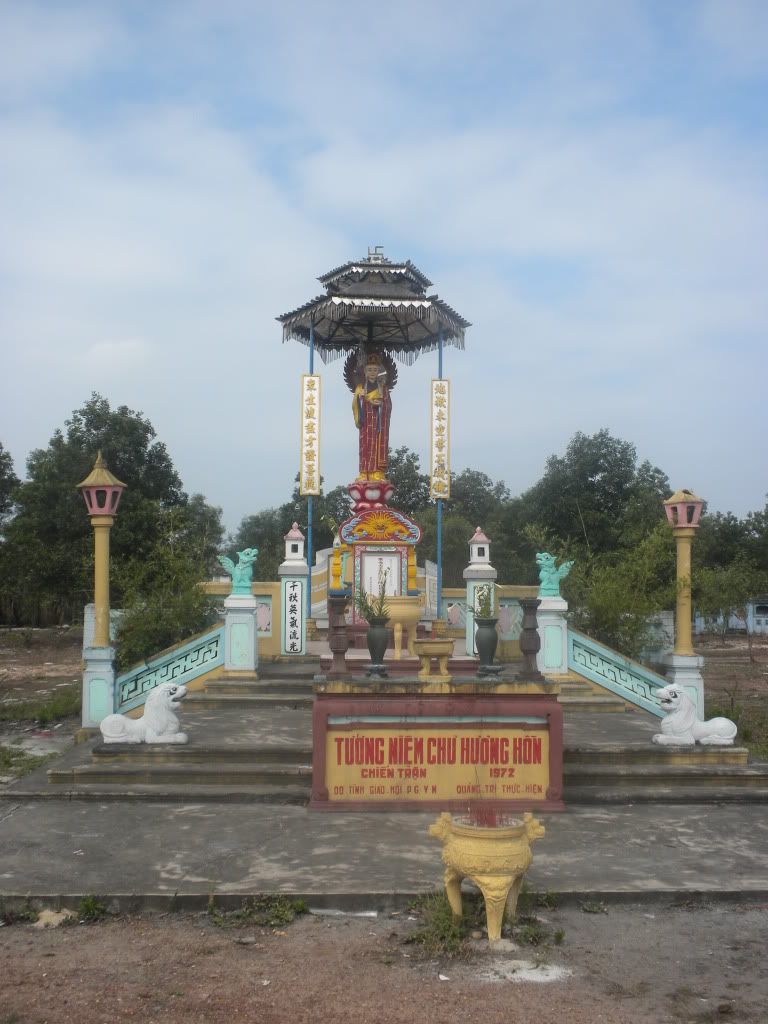
Our second stop followed a little later: the frame of the Catholic Long Hung Church. It was built in 1955, and in 1972 it was the main position of importance in taking over/back the city of Quang Tri. For over 2 months the city and church changed hands daily, with attacks hitting the poor town nonstop. There wasn’t much left of it, and what was left was covered in bullet holes.

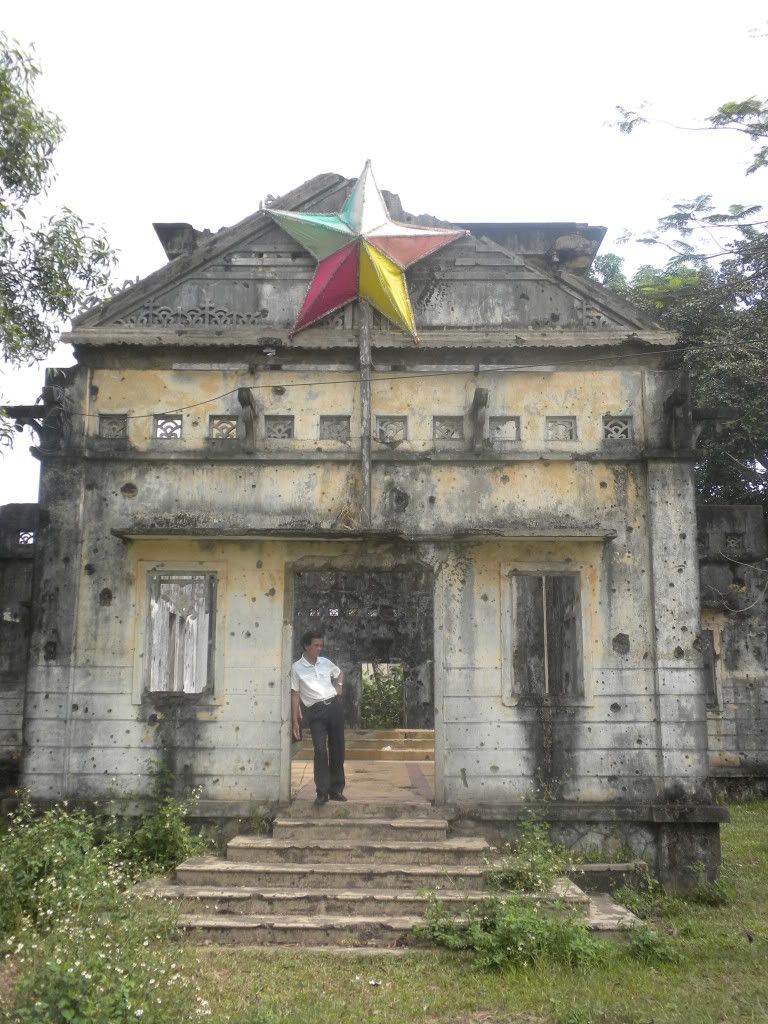
We drove through the DMZ and across the Ben Hai River to the North of Vietnam. We stopped at the Vinh Moc Tunnels. Here’s a short description from the Wiki: “These tunnels were built to shelter the local people from the intense bombing by the Americans. The American forces believed the villagers of Vinh Moc were supplying food and armaments to the North Vietnamese garrison on the island of Con Co which was in turn hindering the American bombers on their way to bomb Hanoi. The idea was to force the villagers of Vinh Moc to leave the area but as is typical in Vietnam there was nowhere else to go. The villagers initially dug the tunnels to move their village 10 meters underground but the American forces designed bombs that burrowed down 10 meters. Eventually against these odds, the villagers moved the village to a depth of 30 meters, creating 3 levels. The tunnels were constructed in several stages beginning in 1966, finished 1.5 years later and used until early 1972. The complex grew to include wells, kitchens, as well rooms for each family and spaces for healthcare. Around 60 families totaling nearly 500 people lived in the tunnels; as many as 17 children were born inside the tunnels. The tunnels were a success and no villagers lost their lives. The only direct hit was from a bomb that failed to explode; the resulting hole was utilized as a ventilation shaft.”
Mr. Trung took us to a small museum with pictures of the locals, where we saw a before and after picture of the Vinh Moc village – the bombs completely flattened the whole place. Outside of the museum we saw a large collection of unexploded bombs, some as heavy as 1500 pounds. Those ones were used to burrow 10 meters deep. Mr. Trung walked us to Entrance No. 3, where we went into the tunnels. The first layer had been reinforced with wooden panels, but as soon as we climbed down to the second level we were surrounded by clay. We spotted some of the tiny family rooms, complete with mannequins. The maternity room looked very uncomfortable, and Mr. Trung shared a horribly anecdote: the babies that had been born underground had mostly gone mute, due to the shell shocks their little bodies couldn’t handle. On the premises was one of these 17 tunnel-babies, now 40 years old and Mr. Trung called him “crazy.”
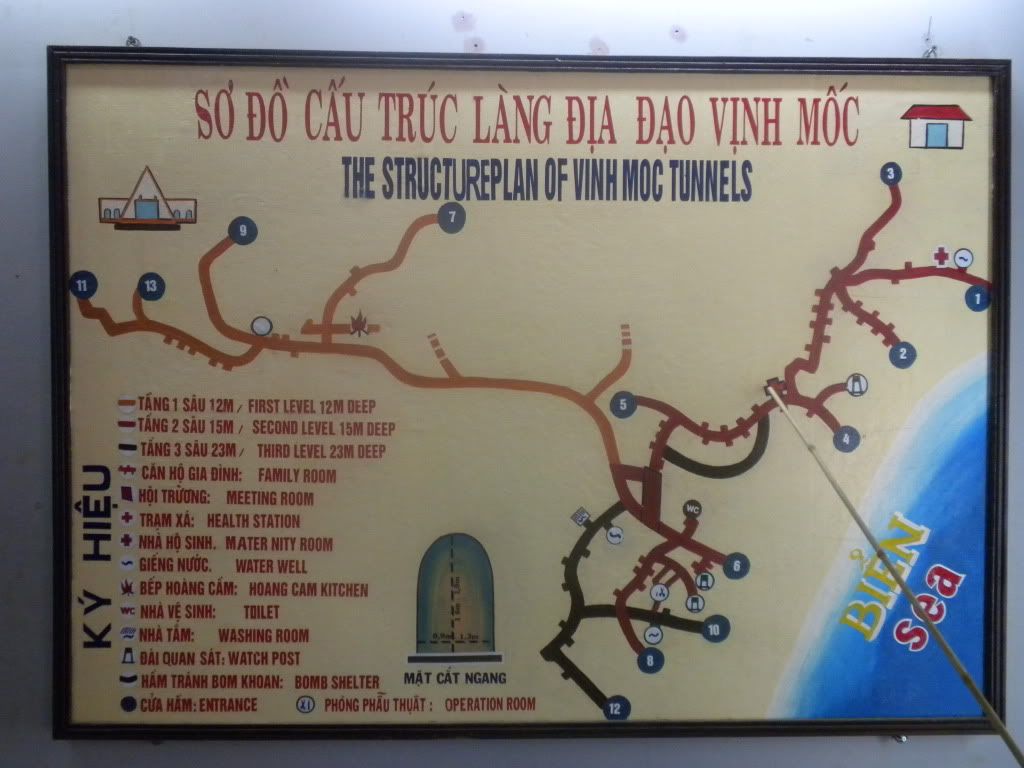
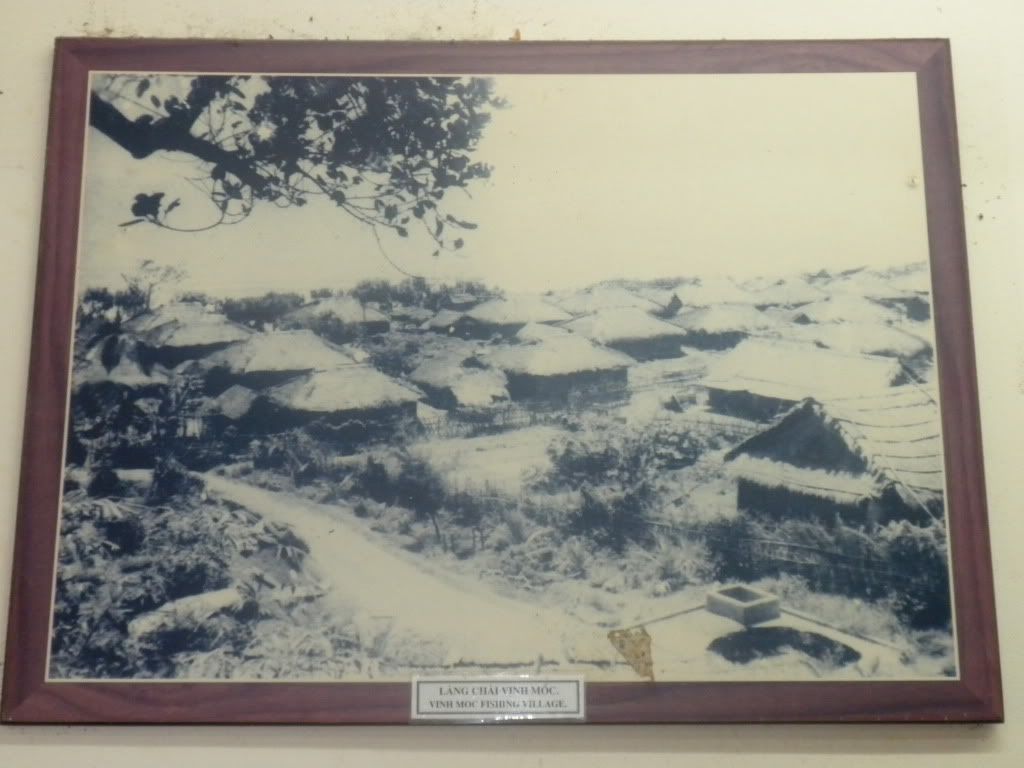
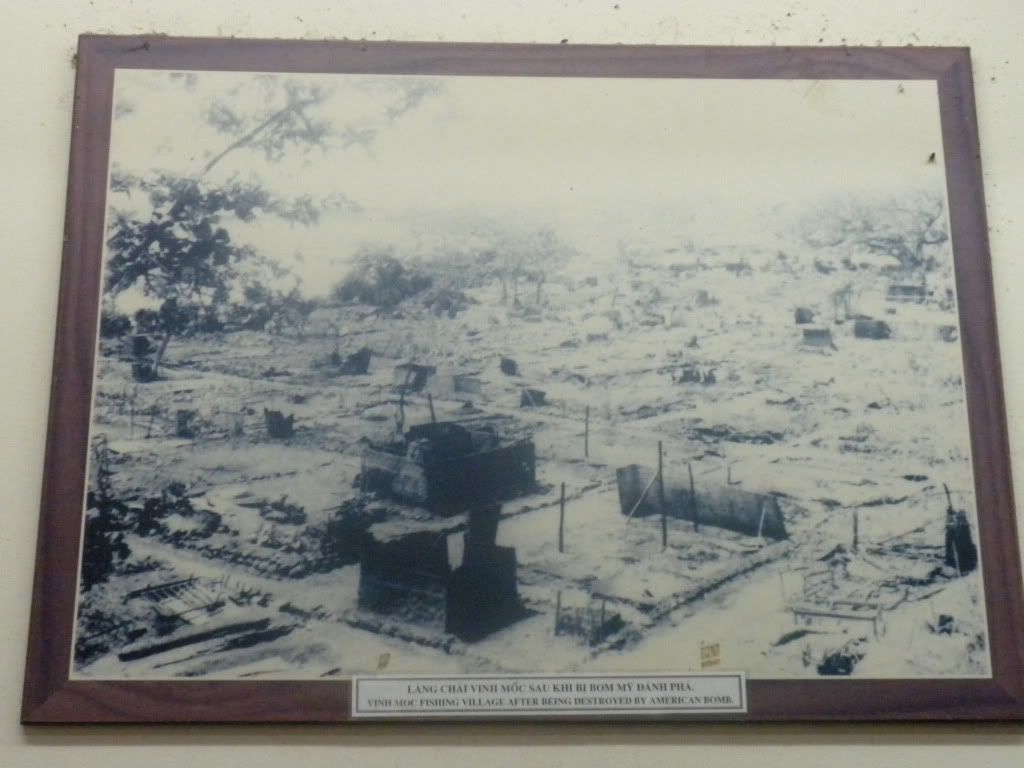
We passed the water well, some airshafts and even a toilet, which connected to the river. We exited the second level and found ourselves looking at the river. The exit was so well hidden in the thick jungle that we instantly understood why there were never any casualties amongst the locals. Even if the pilots saw them running into the jungle they would never know where the entrances might be. We went back inside and descended to the third level, which was nice and cool. Monkey, Puppy and yours truly found another mannequin to hang out with. Next we walked through the operation room, complete with a nurse, a doctor and a patient. The nurse had unfortunately lost her head, so I took it upon myself to play caretaker. We spent our final minutes in the tunnels climbing the stairs back up to ground level.
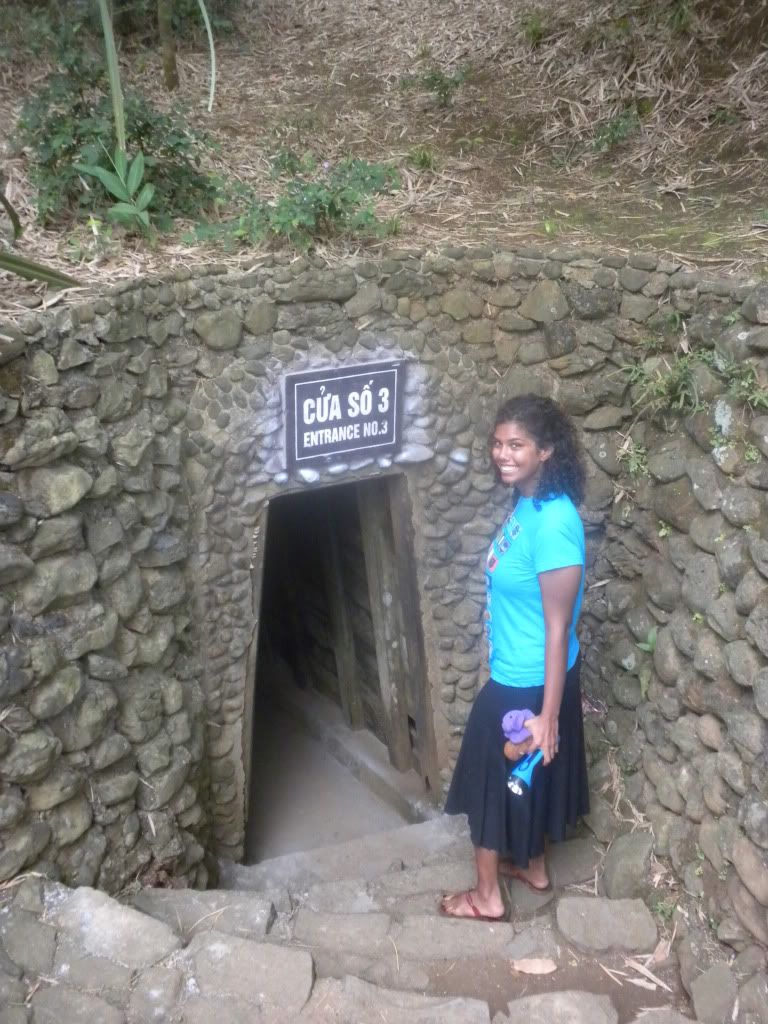
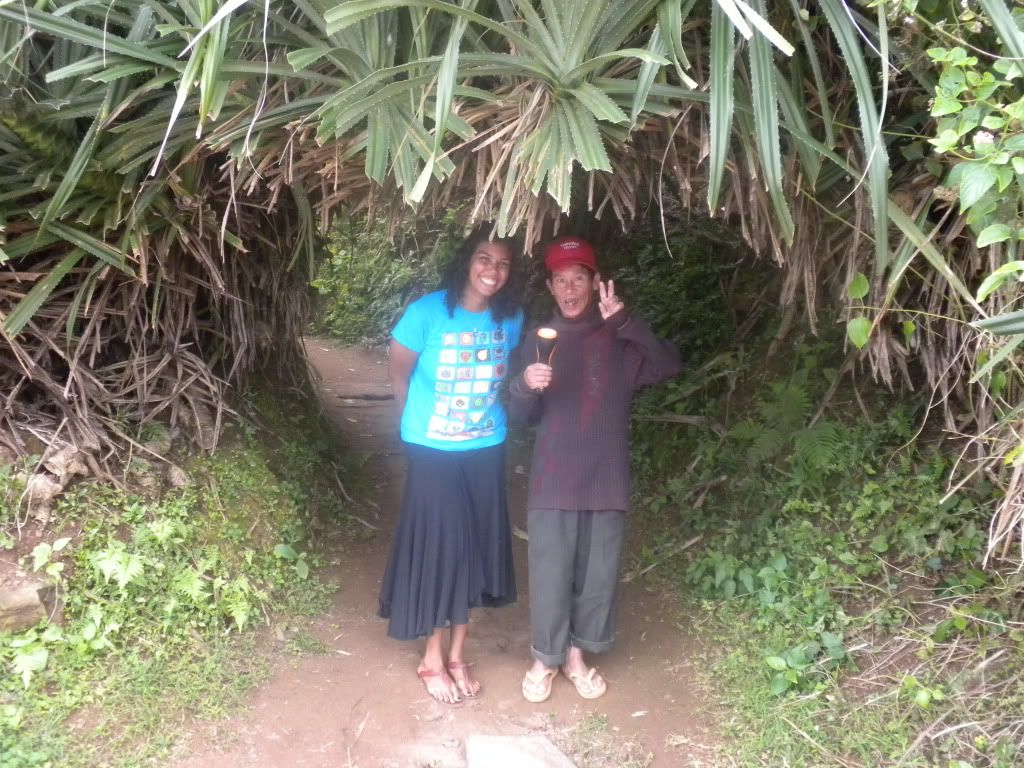

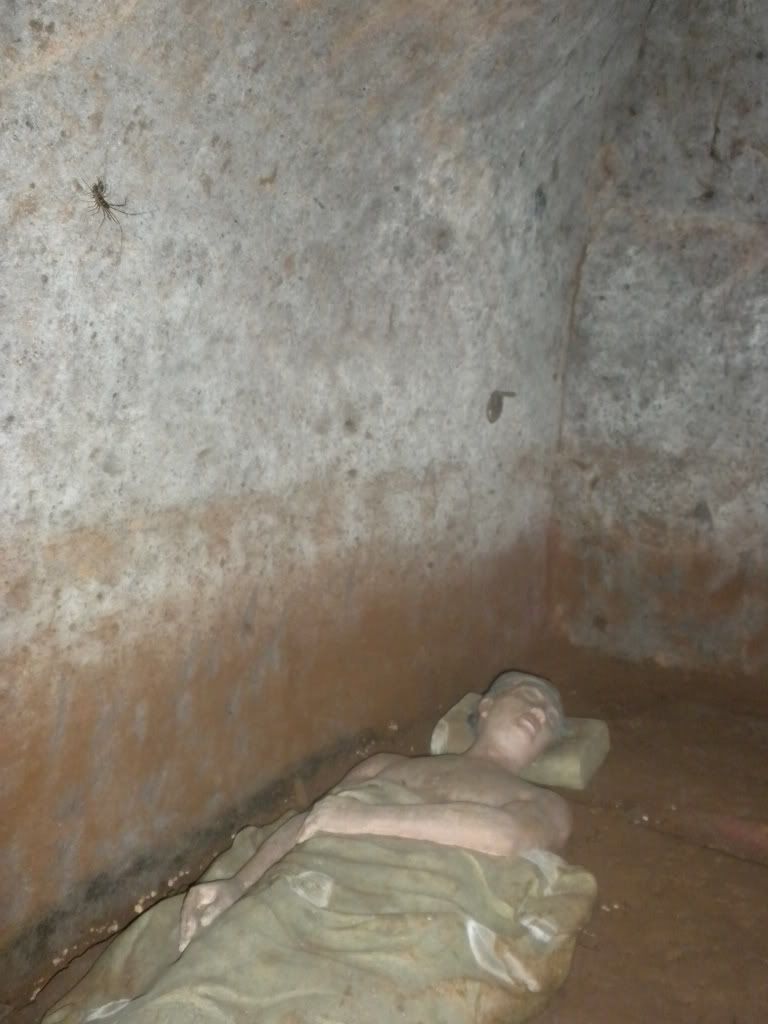
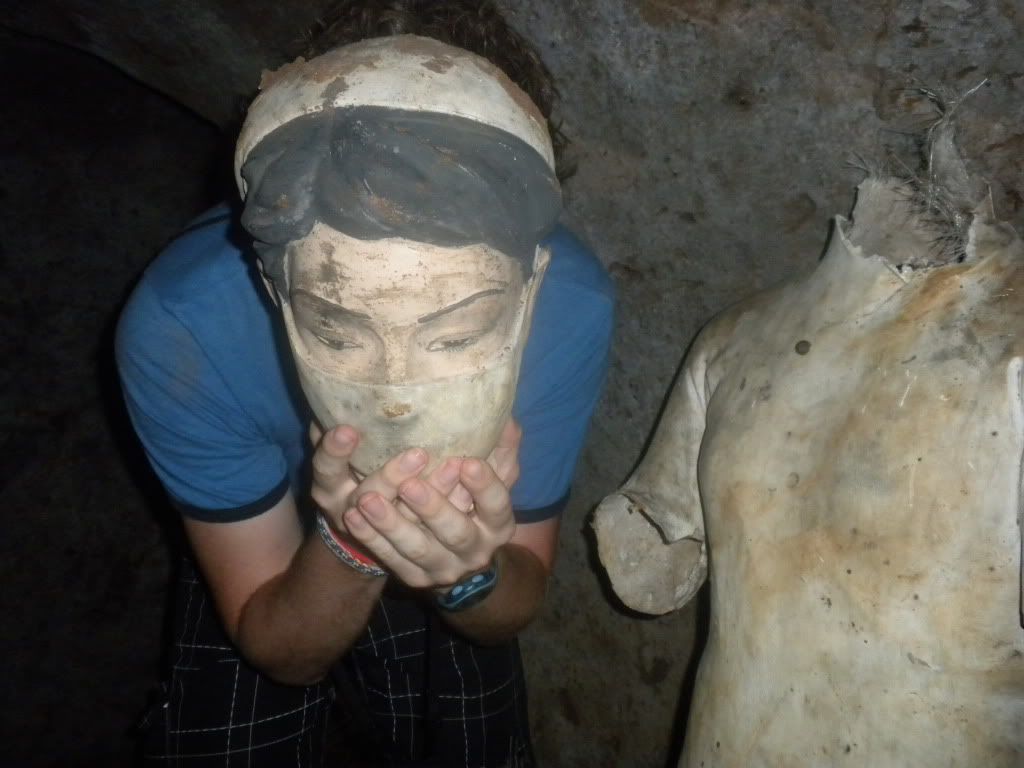
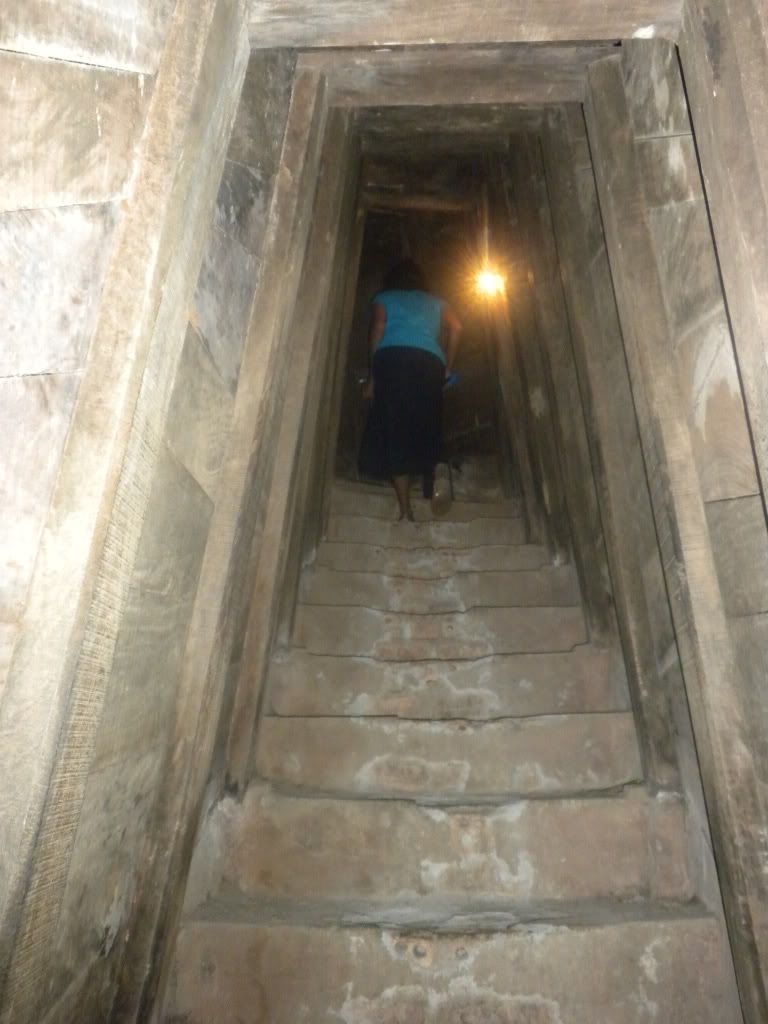
Mr. Trung was a little hungry, so we waited whilst he enjoyed some noodles. Monkey and Puppy had green tea, and Francesca and I had a sip too. Next on the agenda was a look at the little museum on the North side of the Ben Hai River. Here we found a large statue of Ho Chi Minh, still very much revered in these parts. Mr. Trung told us about the battle of Khe Sanh, where a Combat Base was isolated by a large influx of VietCong. The Americans decided to bomb the whole area to smithereens. In the end the Marines got saved. The rest of the museum was still under construction, but most of the photographs on the walls were still hanging. Pictures of young, female VietCong with proud captions, Americans carrying away dead comrades, and Americans running in fear showed us how pro-Communist this area still was.
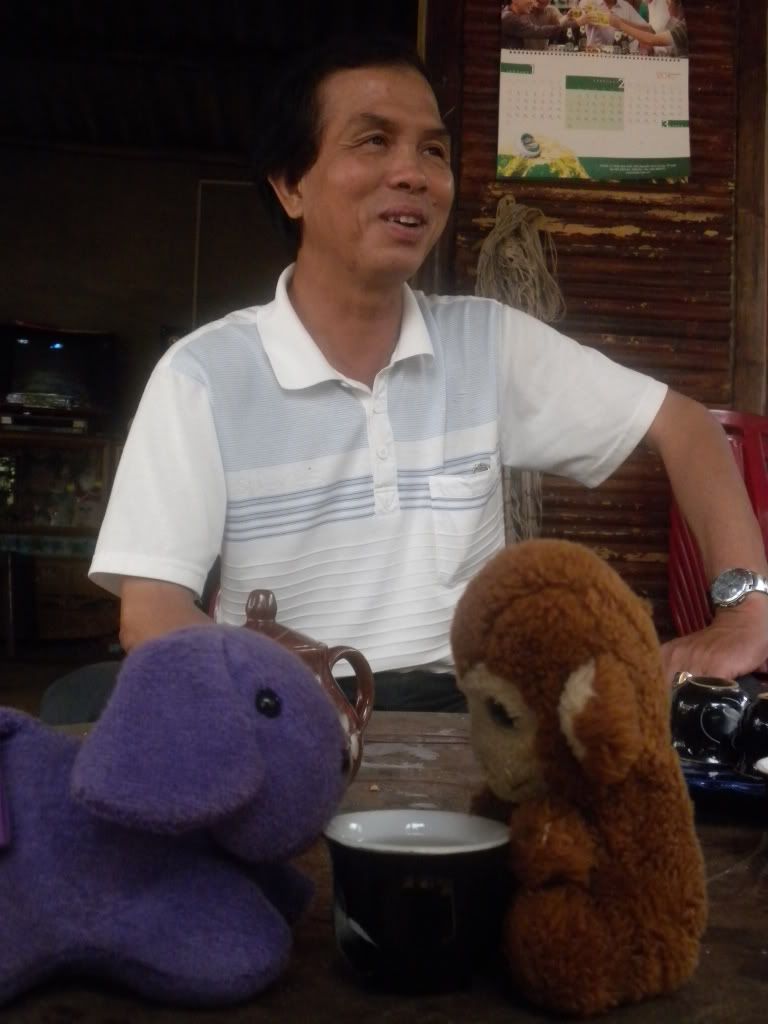
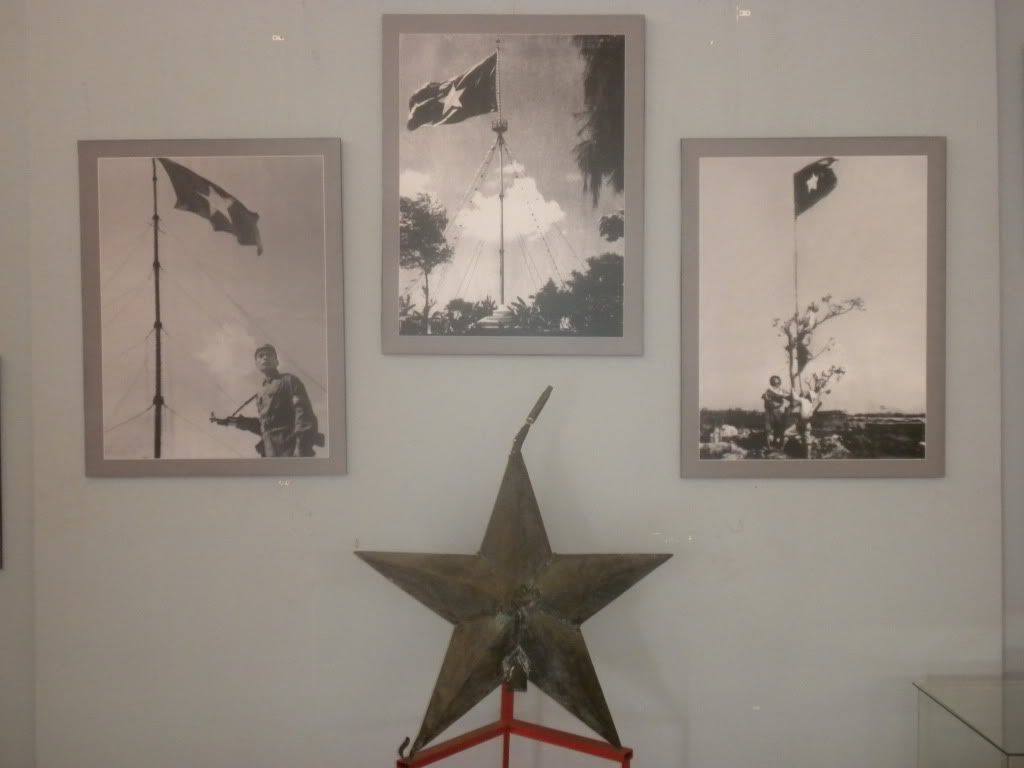
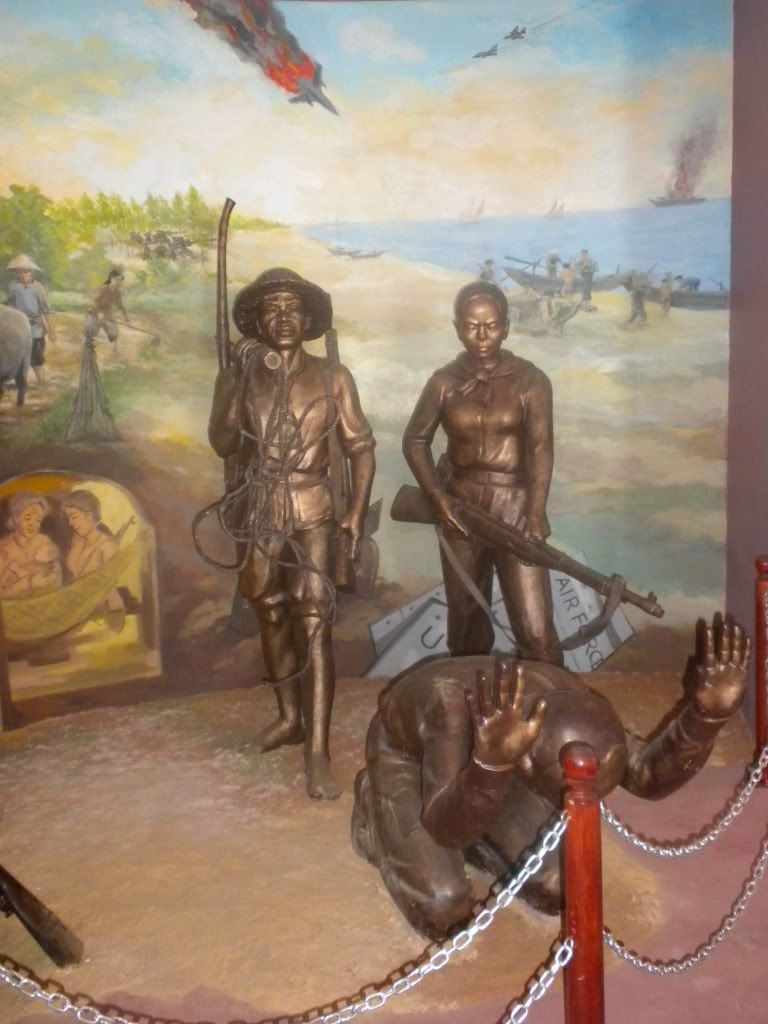
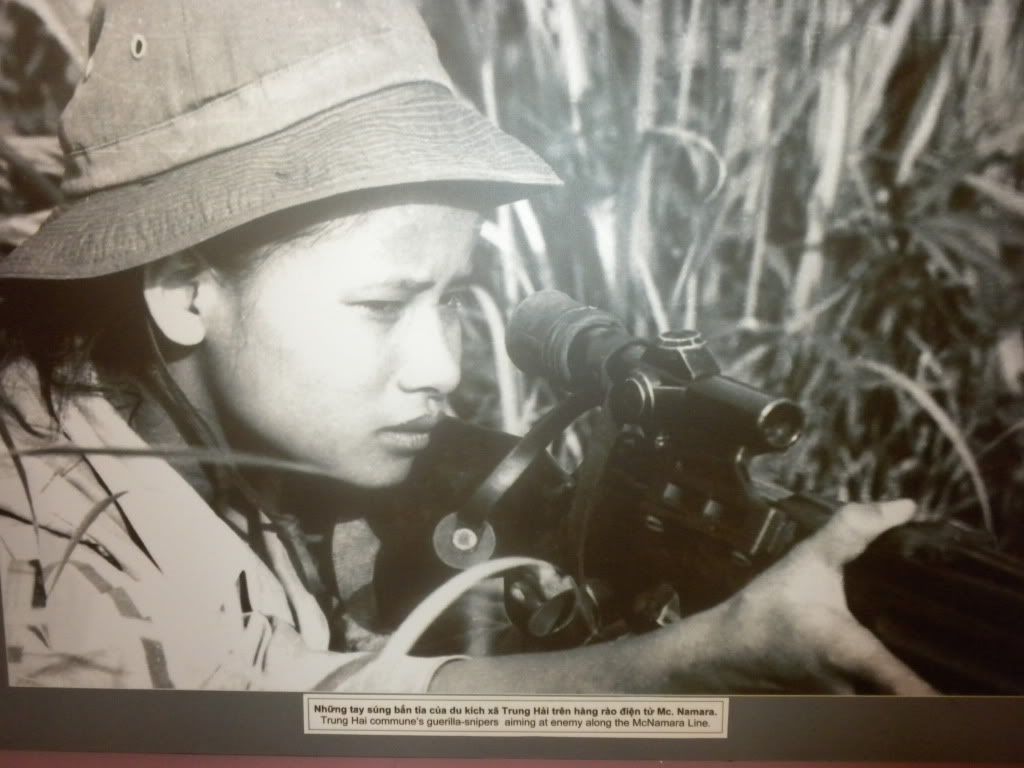
Closer still to the river we saw the border control’s office, where once North and South Vietnamese police once worked together to check passports. Right outside the North Vietnamese had rebuilt the only bridge that ever crossed the Ben Hai, and which had been destroyed in the late sixties. The Hien Luong Bridge connected us with the Southern side, where Francesca and I spotted an original watchtower. Next to the tower people were setting up a large stage, as the Northerners were getting ready for a big celebration of the 35th anniversary of the “liberation” of Ho Chi Minh City on the 30th of April. Francesca and I were thoroughly impressed by a monument a little further up the road, built to commemorate family members who’d never come home.
Our final stop of the day came as we pulled up at the US Doc Mieu Fire Base, part of the American front line comprised a string of firebases set up on a long, low ridge of hills looking north across the DMZ and the featureless plain of the Ben Hai River. The Fire Base is unrecognizable nowadays, safe for the remains of an old abandoned tank, rusting away in the bushes. Across the street Francesca and I had a look at a cemetery for the North Vietnamese that died in the battles in the area. We learned from Mr. Trung that this as a luxury that South Vietnamese fighters often didn’t get.
A nearly 2 hour drive back marked the end of a very informative day in the fields. We thanked Mr. Trung for his great tour and headed upstairs. Around 6:00 PM I went out to pick up a Margherita Pizza and Tagliatelle Bolognese for us, which we happily ate before spending time on our blog and watching TV.
The 26th was a rest day because we left for Hanoi that evening on another sleeper bus. We ate Indian take-away for lunch and brought fruit and sandwiches with us on the bus for dinner. We arrived the next morning... but about that later!

Francesca and I woke up at 7:00 AM to get ready for an early start to the 25th of April. Since I had booked the DMZ tour for us the day before, we were to be picked up at 7:30 AM. At 7:05 AM I was outside already, ordering us some take-away breakfast in the form of a fruit salad, a tuna baguette and a jelly baguette. A little before 7:30 AM Mr. Trung stood outside our hotel, ready to take us on a journey to the past.
As soon as we entered the car Mr. Trung told us the truth about today’s tour. The sites we were going to visit weren’t very special in themselves – in fact, most of them had already been destroyed by Uncle Sam or Mother Nature. It wasn’t the reason we had booked the tour either. Francesca and I really wanted to hear the first-hand account of someone that had actually experienced and lived the Vietnam War (Or American War as they call it here), felt what it was like and could express opinions as well as just facts.
With that minor disclaimer out of the way we got started. Mr. Trung explained he had lived in Hue for most of his life and that he’d been going to college when the war started. His father was a general in the South Vietnamese Army, but young Mr. Trung didn’t want to fight. And when he first came in touch with the South Vietnamese Army it wasn’t a gentle encounter: they thought he was working for the Communists in the North, because he hadn’t joined the Southern cause yet. He was arrested and taken to prison. Mr. Trung admitted he hadn’t been far from joining the Communists after that. However, he ended up choosing to side with the Capitalist South. He said that neutrality really wasn’t an option – that everyone got dragged into the war, in fear of being called a spy. Mr. Trung ended up running a platoon of 10 to 12 soldiers, defending a small bay between Danang and Hoi An, where he fought for 1.5 years.
Vietnam had finally gained independence from the French in 1954 after 100 years of foreign rule. Ho Chi Minh, the famous leader of the North, had gotten the North and South to work together and ousted the Europeans. Ho Chi Minh and his South Vietnamese counterpart Ngo Dinh Diem set out to create an elected government, which with a moderate degree of success ruled the country until 1956. At that point the tentative relationship between Capitalism and Communism failed, and the country became more and more divided. A DeMilitarized Zone (DMZ) was set up around the Ben Hai River on the 17th parallel. Canadian, Polish, Indian and Hungarian U.N. troops were also used to keep an eye on things. Communists in the South and Capitalists in the North had 90 days to move to their favored part of the country before the border would be closed.
The United States watched the whole process carefully, fearing the China and Russia-backed North. The threat of a Northern invasion of the South was very real, and the U.S. feared a domino-effect would ensue in South-East Asia if they let an invasion happen. The Catholic Southern Government, now run by President Ngo Dinh Diem welcomed American financial help, but did not want any military aid. In 1959 The U.S. sent advisors to South Vietnam, whom only reported they couldn’t help the situation. The U.S. Government got desperate and looked for ways to oust the Catholic Government. They knew the Government suppressed the Buddhist population (about 80% of the total population) in the South. At the same time they realized many military leaders came from Buddhist families. With the help of these leaders and their followers the Buddhists protested. The Dien Government beat down on the protesters, which culminated in June, when a monk burned himself in public. Eventually the Dien Government was overthrown in 1963 and a U.S.-backed Government took over.
In 1964 the first American troops started pouring in, and on august 2nd 1964 an American warship off the coast of Vietnam was attacked by the VietCong (Vietnamese Communists; e.g. the North). This gave the Americans the chance to launch their offensive, which started with intense bombing in 1965, followed by the start of the ground war. Whilst the bombing with napalm and Agent Orange were arguably a success, the ground war became a disaster. The VietCong used guerrilla tactics, hiding in tunnels (like Cu Chi), shooting at the Americans from villages in the dark. The Americans then checked the villages, finding only old people and children. Frustrated by the unseen enemies they burned down villages, creating only more opposition against their presence amongst the population.
The DMZ, deemed to be the most vital part in the defense against the North, was defended by 1 Division of the American Navy and 1 Division of the South Vietnamese Army. Their combined total of 37.000 men was no match for the 100.000 VietCongs the North brought. Their reinforcements and supplies were cut off whilst they were only attacked from a distance, only at night, not once seeing an enemy to shoot out. Eventually the Americans were forced to retreat in 1972, due to international pressure and military failure, losing nearly 60.000 men in the process.
The war wasn’t over for Mr. Trung and the other Vietnamese though. After the Americans retreated all the way to Saigon, the southern capital, the South became easy prey. The North swooped over the country, taking village after village and city after city. In the early hours of the 30th of April 1975 Saigon was abandoned by the last American troops and the city taken by the Vietcong. The city was renamed to Ho Chi Minh City, honoring the former leader of the North, who had passed away in 1969. Mr. Trung was captured and sent to prison for several years to be “re-educated.” Depending on rank in the army others got fewer or more years. He did not tell us much about his years here, only that he nearly starved, saw friends die and ate food poisoned with Agent Orange. It took him several years after his release to recover, sweating out the toxins in his body as he worked hard as a farmer.
Nowadays Vietnam is still ruled by the Communists, even though they don’t adhere to their former ideals a lot. Most of the party members have gotten rich, building hotels and thriving off tourism. The one-party-system ensures nepotism continues, and Mr. Trung fears this will stay the same for many years to come. The past still hunts the Southerners as they are discriminated against on the job market. Political careers or governmental hobs are impossible if your father fought for the South. Mr. Trung laughed when Francesca asked if it would be possible if someone’s parents fought for the South if they could become police officers. He sounded bitter; again fearing younger generations would continue to feel the pain of the war.
As we got our history lesson we stopped at several sites. Our first stop was a memorial along the “Horror Highway,” a highway on which over 10.000 civilians and soldiers died as they fled the North Vietnamese invaders. A report from 1972 said bulldozers were used to clear the human remains which literally covered the streets. In 2010 all that remains is a simple monument commemorating the victims of this genocide.

Our second stop followed a little later: the frame of the Catholic Long Hung Church. It was built in 1955, and in 1972 it was the main position of importance in taking over/back the city of Quang Tri. For over 2 months the city and church changed hands daily, with attacks hitting the poor town nonstop. There wasn’t much left of it, and what was left was covered in bullet holes.


We drove through the DMZ and across the Ben Hai River to the North of Vietnam. We stopped at the Vinh Moc Tunnels. Here’s a short description from the Wiki: “These tunnels were built to shelter the local people from the intense bombing by the Americans. The American forces believed the villagers of Vinh Moc were supplying food and armaments to the North Vietnamese garrison on the island of Con Co which was in turn hindering the American bombers on their way to bomb Hanoi. The idea was to force the villagers of Vinh Moc to leave the area but as is typical in Vietnam there was nowhere else to go. The villagers initially dug the tunnels to move their village 10 meters underground but the American forces designed bombs that burrowed down 10 meters. Eventually against these odds, the villagers moved the village to a depth of 30 meters, creating 3 levels. The tunnels were constructed in several stages beginning in 1966, finished 1.5 years later and used until early 1972. The complex grew to include wells, kitchens, as well rooms for each family and spaces for healthcare. Around 60 families totaling nearly 500 people lived in the tunnels; as many as 17 children were born inside the tunnels. The tunnels were a success and no villagers lost their lives. The only direct hit was from a bomb that failed to explode; the resulting hole was utilized as a ventilation shaft.”
Mr. Trung took us to a small museum with pictures of the locals, where we saw a before and after picture of the Vinh Moc village – the bombs completely flattened the whole place. Outside of the museum we saw a large collection of unexploded bombs, some as heavy as 1500 pounds. Those ones were used to burrow 10 meters deep. Mr. Trung walked us to Entrance No. 3, where we went into the tunnels. The first layer had been reinforced with wooden panels, but as soon as we climbed down to the second level we were surrounded by clay. We spotted some of the tiny family rooms, complete with mannequins. The maternity room looked very uncomfortable, and Mr. Trung shared a horribly anecdote: the babies that had been born underground had mostly gone mute, due to the shell shocks their little bodies couldn’t handle. On the premises was one of these 17 tunnel-babies, now 40 years old and Mr. Trung called him “crazy.”



We passed the water well, some airshafts and even a toilet, which connected to the river. We exited the second level and found ourselves looking at the river. The exit was so well hidden in the thick jungle that we instantly understood why there were never any casualties amongst the locals. Even if the pilots saw them running into the jungle they would never know where the entrances might be. We went back inside and descended to the third level, which was nice and cool. Monkey, Puppy and yours truly found another mannequin to hang out with. Next we walked through the operation room, complete with a nurse, a doctor and a patient. The nurse had unfortunately lost her head, so I took it upon myself to play caretaker. We spent our final minutes in the tunnels climbing the stairs back up to ground level.






Mr. Trung was a little hungry, so we waited whilst he enjoyed some noodles. Monkey and Puppy had green tea, and Francesca and I had a sip too. Next on the agenda was a look at the little museum on the North side of the Ben Hai River. Here we found a large statue of Ho Chi Minh, still very much revered in these parts. Mr. Trung told us about the battle of Khe Sanh, where a Combat Base was isolated by a large influx of VietCong. The Americans decided to bomb the whole area to smithereens. In the end the Marines got saved. The rest of the museum was still under construction, but most of the photographs on the walls were still hanging. Pictures of young, female VietCong with proud captions, Americans carrying away dead comrades, and Americans running in fear showed us how pro-Communist this area still was.




Closer still to the river we saw the border control’s office, where once North and South Vietnamese police once worked together to check passports. Right outside the North Vietnamese had rebuilt the only bridge that ever crossed the Ben Hai, and which had been destroyed in the late sixties. The Hien Luong Bridge connected us with the Southern side, where Francesca and I spotted an original watchtower. Next to the tower people were setting up a large stage, as the Northerners were getting ready for a big celebration of the 35th anniversary of the “liberation” of Ho Chi Minh City on the 30th of April. Francesca and I were thoroughly impressed by a monument a little further up the road, built to commemorate family members who’d never come home.
Our final stop of the day came as we pulled up at the US Doc Mieu Fire Base, part of the American front line comprised a string of firebases set up on a long, low ridge of hills looking north across the DMZ and the featureless plain of the Ben Hai River. The Fire Base is unrecognizable nowadays, safe for the remains of an old abandoned tank, rusting away in the bushes. Across the street Francesca and I had a look at a cemetery for the North Vietnamese that died in the battles in the area. We learned from Mr. Trung that this as a luxury that South Vietnamese fighters often didn’t get.
A nearly 2 hour drive back marked the end of a very informative day in the fields. We thanked Mr. Trung for his great tour and headed upstairs. Around 6:00 PM I went out to pick up a Margherita Pizza and Tagliatelle Bolognese for us, which we happily ate before spending time on our blog and watching TV.
The 26th was a rest day because we left for Hanoi that evening on another sleeper bus. We ate Indian take-away for lunch and brought fruit and sandwiches with us on the bus for dinner. We arrived the next morning... but about that later!

1 Comments:
Lieve schat,
Wat een indrukwekkende foto's!! her en der had ik nog een heleboel niet gezien.
Ben nog niet helemaal bijgelezen, maar er komen 4 vrije dagen aan ;)
Ben ook erg benieuwd hoe het in Hong Kong is.
Kus
Mams
ps
oma is de komende tijd niet on air, holiday, but you knew... x
Post a Comment
<< Home